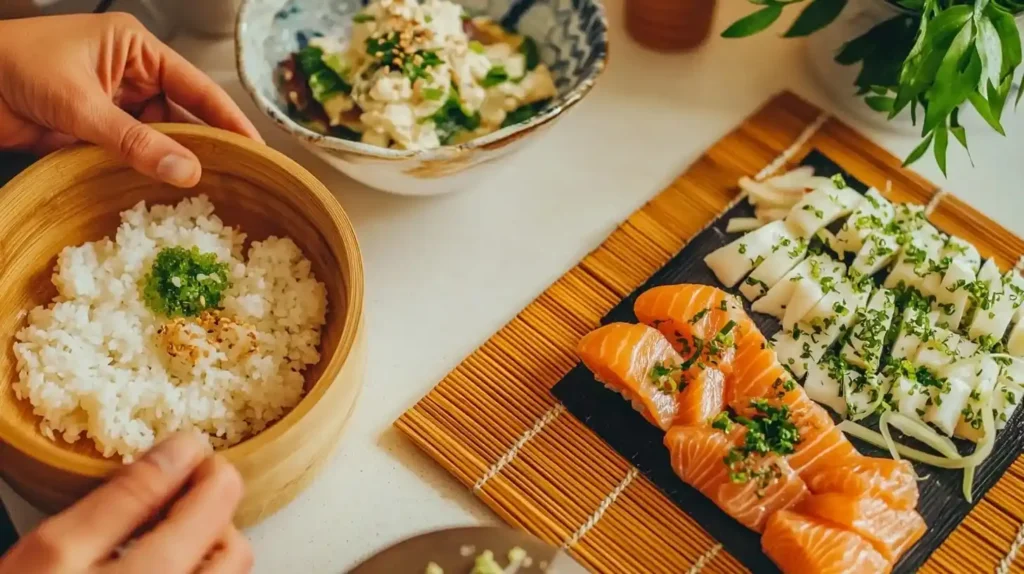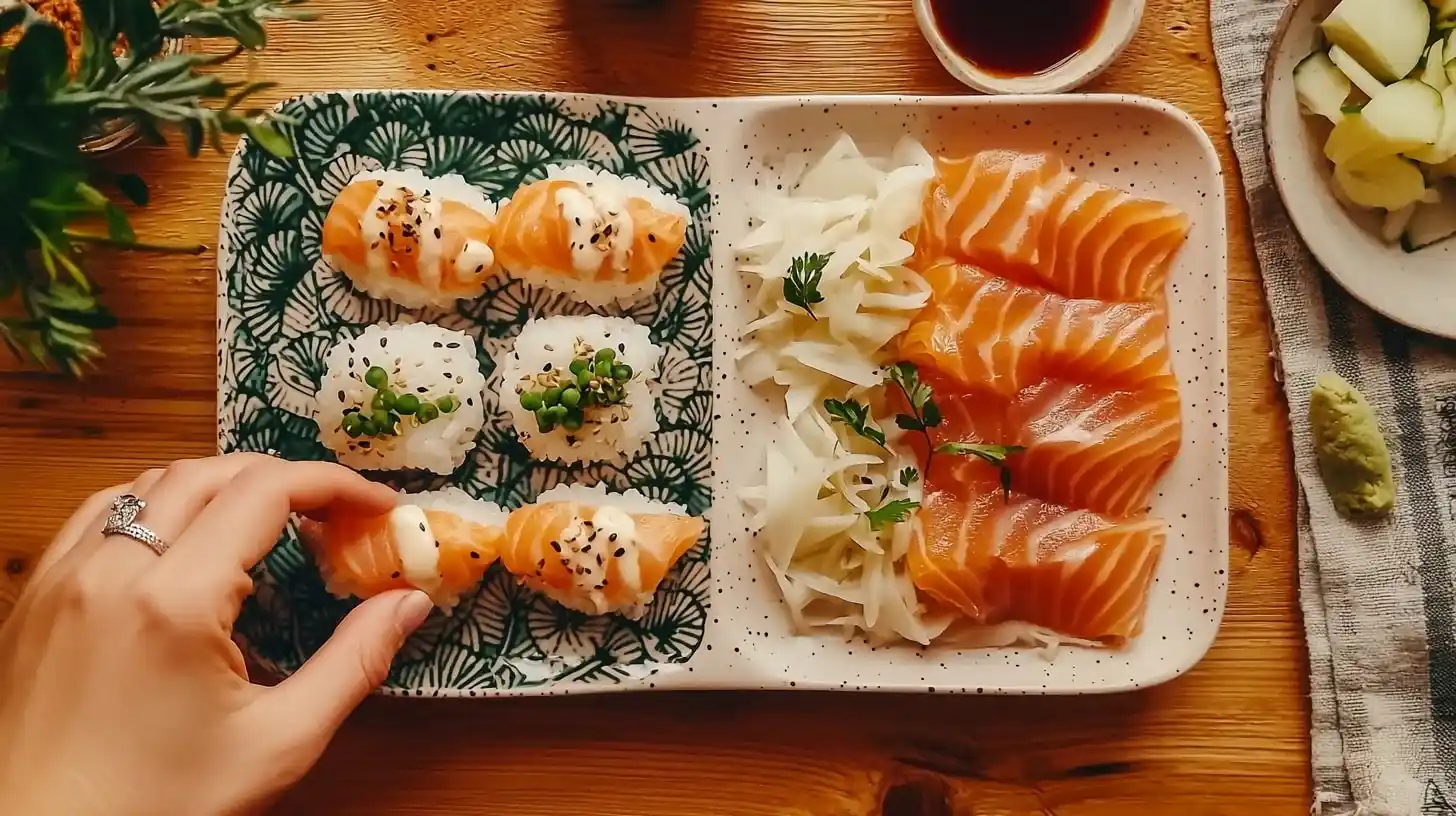“Is this sushi?” my youngest son asked, pointing to the beautifully arranged slices of raw salmon I’d just placed on the table. His question highlighted a common confusion many have about Japanese cuisine – the distinctions between different raw fish preparations.What Is Nigiri vs Sashimi?.
The terms nigiri, sashimi, and sushi are often used interchangeably in casual conversation, but they represent distinct Japanese culinary traditions with specific preparation methods and serving styles.
Understanding these differences enhances appreciation of Japanese cuisine and helps navigate both restaurant menus and home preparation. My family’s exploration of these distinctions has transformed our Japanese dining experiences both at restaurants and in our own kitchen.
Table of Contents
What Is Nigiri vs Sashimi? Key Differences at a Glance

What Is Nigiri vs Sashimi? Show Main Image Nigiri (left) features fish atop seasoned rice, while sashimi (right) showcases the fish alone – two distinct Japanese delicacies with their own traditions!
The fundamental difference between nigiri and sashimi is simple: nigiri includes rice, sashimi does not.
Nigiri (pronounced nee-gee-ree) consists of a small, hand-pressed mound of vinegared rice topped with a slice of fish or seafood.
Sashimi (pronounced sah-shee-mee) features only thin slices of raw fish or seafood with no rice, typically garnished with daikon radish.
Both are distinct from sushi rolls (maki), which wrap rice and fillings in seaweed.
My daughter’s clever reminder helps our family remember the difference: “Nigiri needs rice, sashimi stands solo.”
For more globally-inspired recipes including Japanese cuisine, explore our International Lunch Inspirations: Global Flavors Made Simple collection.
Nigiri: The Perfect Balance of Fish and Rice
Nigiri represents the harmony of two elements: perfectly seasoned rice and quality fish or seafood.
The rice base (shari) is seasoned with rice vinegar, sugar, and salt – a mixture called sushi-su that gives it distinctive flavor.
A small amount of wasabi is traditionally placed between the rice and fish, providing both flavor and antibacterial properties.
Common nigiri toppings include salmon, tuna, yellowtail, shrimp, eel, and various shellfish.
Salmon Nigiri has become particularly popular in Western countries for its mild flavor and buttery texture.
For those wondering about salmon preparation specifically, Is salmon nigiri raw? explains that while traditionally raw, variations like torched (aburi) salmon offer alternatives.
The compact, two-bite size of nigiri makes it perfect for introducing Japanese cuisine to hesitant family members. My middle child initially approached it saying, “Small enough to try, big enough to enjoy.”
Sashimi: The Pure Expression of Fish
Sashimi represents the purest expression of fish quality, with nothing to mask or complement its natural flavors.
This minimalist preparation demands the absolute freshest, highest-quality fish as it stands completely on its own.
Precise knife skills are essential – the fish is cut at specific angles to optimize texture and mouthfeel.
Traditional garnishes include shredded daikon radish (tsuma), shiso leaves, and sometimes flower-shaped vegetables.
While various seafood can become sashimi, bluefin tuna (maguro) is considered the ultimate expression of the form.
Those curious about flavor profiles might wonder What does salmon nigiri taste like? – while similar to salmon sashimi, the rice in nigiri provides a contrasting texture and subtle sweetness.
My husband, initially hesitant about raw fish, started his Japanese culinary journey with sashimi, noting, “Without rice or other elements, you truly experience the ocean’s essence.”What Is Nigiri vs Sashimi?.
Preparation Techniques Compared
Show Preparation Comparison Image The preparation tells the story: nigiri requires perfect rice technique, while sashimi demands masterful knife skills – each art form with its own challenges!
Nigiri preparation focuses on rice handling and forming:
- Rice must be cooled to body temperature while mixing with vinegar solution
- Hand-pressing requires specific pressure – firm enough to hold together but not so much that rice becomes dense
- The shape should be an oval with slightly rounded top and flat bottom
- Each piece should be uniform in size – typically about 3cm long
Sashimi preparation emphasizes knife work and presentation:
- Fish must be filleted along natural muscle divisions
- Slicing technique varies by fish type – some across the grain, others at an angle
- Thickness is precisely controlled – typically 7-8mm
- Arrangement follows aesthetic principles with consideration for color contrast and spacing
My attempts at making both at home revealed different challenges – nigiri tested my ability to handle rice without it becoming sticky or dense, while sashimi demanded precision in knife work I’m still developing.
For comprehensive meal ideas beyond Japanese cuisine, our Family-Friendly Lunch Recipes: Effortless Meals for Busy Parents collection offers additional inspiration.
When to Choose Each Style
Different occasions and preferences might lead you to choose one style over the other:
Choose nigiri when:
- You prefer a more filling option (the rice provides substance)
- You’re new to Japanese cuisine (rice provides familiar texture)
- You appreciate the balance of flavors between rice and fish
- You’re serving a meal rather than appetizers
Choose sashimi when:
- You want to experience the pure flavor of the fish
- You’re following a low-carb eating plan
- You’re serving an elegant appetizer course
- You have access to exceptional quality fish
For those concerned about nutritional aspects, Is salmon nigiri healthy for you? explores how both nigiri and sashimi offer health benefits, with nigiri adding carbohydrates from rice.
My family’s Japanese meals now typically include both styles – sashimi as a starter and nigiri as part of the main course, a pattern we’ve observed in traditional Japanese dining as well.
Answers to Your Nigiri and Sashimi Questions
Is one more “authentic” than the other? Both nigiri and sashimi have authentic roots in Japanese culinary tradition. Sashimi predates nigiri historically, with records dating back to the 14th century, while nigiri emerged in the 19th century.
Which is easier for beginners to make at home? Nigiri is generally more approachable for home cooks, as slight imperfections in fish cutting are less noticeable. My first attempts at both confirmed this – our homemade nigiri looked presentable while our sashimi revealed my novice cutting skills.
Do you eat them differently? Yes – nigiri is traditionally eaten with fingers, turned upside down, and dipped fish-side into soy sauce. Sashimi is eaten with chopsticks and dipped lightly in soy sauce mixed with wasabi.
Bringing Japanese Traditions to Your Family Table
Understanding the distinction between nigiri and sashimi enhances appreciation of Japanese culinary traditions and helps make informed choices when dining out or preparing these dishes at home.
Both preparations celebrate the essential Japanese concept of letting quality ingredients speak for themselves through minimal intervention.
Whether you prefer the harmonious partnership of fish and rice in nigiri or the pure, unadorned expression of fish in sashimi, both offer windows into Japan’s rich food culture.
My family’s exploration of these distinctions has deepened our appreciation for Japanese cuisine while creating new traditions around our own table – proving that understanding food differences creates not just knowledge but connection.
With warmth, Sophia





